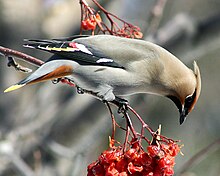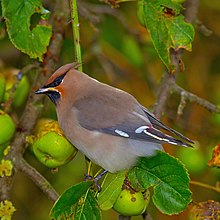22:56
@Cerberus How do you say borborygm? Is it /ˈbo˞bəɹɪm/ for you?
Not especially helpful, that.
By the way, that first word gave us the family and genus for the lovely waxwings.
> Waxwings are characterised by soft silky plumage. (Bombycilla, the genus name, is Vieillot's attempt at Latin for "silktail", translating the German name Seidenschwänze.)
Or whatever Zederwachsschwingen are in Dutch.
"Cedar waxwings", obviously, in English.
Jaseur d'Amérique in French.
Wait, which ones are yours?
Oh, you just have the noisy ones not the cedar ones.
You only have Bombycilla garrulus, not B. cedrorum. We have both; yours we for whatever reason call Bohemian.

The waxwings are passerine birds classified in the genus Bombycilla. They are brown and pale grey with silky plumage, a black and white eyestripe, a crest, a square-cut tail and pointed wings. Some of the wing feathers have red tips, the resemblance of which to sealing wax gives these birds their common name. According to most authorities, this is the only genus placed in the family Bombycillidae, although Phainoptila is sometimes included. There are three species, the Bohemian waxwing (B. garrulus), the Japanese waxwing (B. japonica) and the cedar waxwing (B. cedrorum).
Waxwings are not long...

Der Seidenschwanz (Bombycilla garrulus) ist ein Singvogel aus der
Familie der Seidenschwänze (Bombycillidae). Zwei (oder drei) wenig differenzierte Unterarten werden unterschieden: neben der Nominatform die nearktische Rasse B. g. pallidiceps sowie die in ihrem taxonomischen Rang etwas unklare Varietät (oder Unterart) B. g. centralasiae.
== Beschreibung ==
Der Seidenschwanz wird bis 18 cm groß und wiegt 50 bis 60 Gramm. Aus der Ferne wirken die knapp starengroßen Vögel eher unauffällig rostgraubraun, aus der Nähe sind sie jedoch sehr auffällig und bunt.
Auffälligstes und unverkennbares Kennzeichen…
Closest I can find to Dutch.
I’m still staring at borborygm.

De pestvogel (Bombycilla garrulus) is een zangvogel uit de familie van de pestvogels (Bombycillidae). De wetenschappelijke naam van de soort werd als Lanius garrulus in 1758 gepubliceerd door Carl Linnaeus. De vogel heeft het formaat van een lijster, en opvallende kleuren. De naam "pestvogel" dateert uit de middeleeuwen, toen men dacht dat deze vogels de pest meenamen en de ziekte verspreidden.
== Kenmerken ==
De pestvogel is een lijsterachtige vogel met zalmroze kleur, en gele streepjes op de vleugels. De kop draagt een flinke kuif en een zwart maskertje en keeltje. De anaalstreek is roodbruin...
> De naam "pestvogel" dateert uit de middeleeuwen, toen men dacht dat deze vogels de pest meenamen en de ziekte verspreidden.
You appear not to have a word for irruption, which is the explosive surfeit of some critter.
> Het is een invasiegast die soms in grote aantallen in Nederland overwintert. [...] Tijdens een invasie zijn ze te zien in steden en dorpen, vaak in de omgeving van bessendragende struiken zoals de meidoorn en gelderse roos.
> The action of bursting or breaking in; a violent entry, inroad, incursion, or invasion, esp. of a hostile force or tribe. spec. An abrupt local increase in the numbers of a species of animals.
14

 With paradigm and paradigmatic, just as with phlegm and phlegmatic, English only allows that g to be sounded when you can split a syllable. (The unassimilated version with a final ‑a technically does still exist, but the OED calls it “rare”.)
This is all because the phonotactics of English (the ...
With paradigm and paradigmatic, just as with phlegm and phlegmatic, English only allows that g to be sounded when you can split a syllable. (The unassimilated version with a final ‑a technically does still exist, but the OED calls it “rare”.)
This is all because the phonotactics of English (the ...
Loud noises are phonotaxing. :)